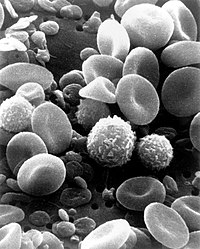
Photo from wikipedia
Blood cell production is complex, partly genetically determined and influenced by acquired factors. However, there is a paucity of data on how these factors interplay in the context of aging,… Click to show full abstract
Blood cell production is complex, partly genetically determined and influenced by acquired factors. However, there is a paucity of data on how these factors interplay in the context of aging, which is associated with a myeloid proliferation bias, clonal hematopoiesis (CH) and an increased incidence of myeloid cancers. We investigated hereditary and acquired factors underlying blood cell trait variability in a cohort of 2996 related and unrelated women from Quebec aged 55 to 101 years. We performed a genome-wide association study, evaluated the impact of chronic diseases and performed targeted deep sequencing of CH driver genes and X-chromosome inactivation (XCI)-based clonality analyses. Multivariable analyses were conducted using generalized linear mixed models. We document that aging is associated with increasing neutrophil and monocyte counts and decreasing lymphocyte counts. Neutrophil counts were influenced by variants in the region of GSDMA and PSMD3-CSF3 but this association decreased with age. In parallel, aging individuals with cardiometabolic comorbidities exhibited significantly higher neutrophil counts (4.1x109/L vs 3.83x109/L, p-value <0.001). These age-related diseases were also associated with an increase in other myeloid-derived cells. Neither CH or XCI clonality correlated with neutrophil counts. In conclusion, we show that neutrophils counts are genetically influenced, but as individuals age this contribution decreases in favor of acquired factors. Aging is associated with a myeloid proliferation bias which is greater in the presence of cardiometabolic comorbidities but not of CH. These findings support that cell-extrinsic factors may contribute to the myeloid shift possibly through low-grade inflammation.
Journal Title: Blood advances
Year Published: 2023
Link to full text (if available)
Share on Social Media: Sign Up to like & get
recommendations!